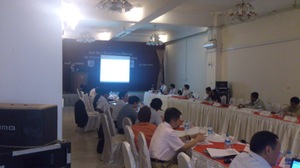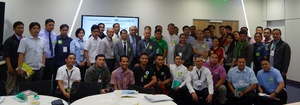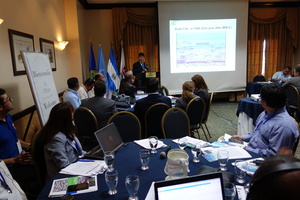
Activity Report
18th-21th November 2014 (Yangon, Myanmar)
 ADRC participated in the meeting named above, which was organized by the Japan Aerospace Exploration Agency (JAXA) and the Myanmar Earthquake Committee (MEC), from 18 to 21 November 2014 in Yangon, Myanmar. The meeting was attended by approximately 60 participants including representatives of satellite agencies and academic institutions in Japan, Thailand, and Myanmar. The meeting primarily consisted of the following.
ADRC participated in the meeting named above, which was organized by the Japan Aerospace Exploration Agency (JAXA) and the Myanmar Earthquake Committee (MEC), from 18 to 21 November 2014 in Yangon, Myanmar. The meeting was attended by approximately 60 participants including representatives of satellite agencies and academic institutions in Japan, Thailand, and Myanmar. The meeting primarily consisted of the following.
-Overall status of Sentinel Asia
-Activations of satellite agencies
-Report on the disaster status, and disaster prevention and mitigation measures in Myanmar
-Report on technologies that use satellites and the dissemination of those technologies by international agencies-Report on projects that use satellite images
-Report on the cultivation of human resources in the use of satellite imagery and introductions to mini-projects-Working group reports: Earthquakes and Landslides, Floods, Wildfires and GLOF
ADRC gave two presentations, covering the activation of emergency observations and the satisfaction of system users based on a questionnaire survey conducted on Sentinel Asia.
According to the questionnaire findings, a result with the satisfaction is almost provided about the time to data offer from a request and the offered image.
(2014/11/18 13:50)
11-12 November, 2014 (San Salvador, El Salvador)
ADRC/IRP, in collaboration Central America's Center for Disaster Prevention (CEPREDENAC), had organized an Intergovernmental Dialogue on Recovery Processes, 11-12 November 2014 at Hilton Princess Hotel in San Salvador, El Salvador. The event was also strongly supported by UNISDR and UNDP. The main objective of the dialogue was to facilitate knowledge exchange so that government organizations and cities can improve their programs based on the sharing of experiences. The discussions dwelt on: How have recovery processes been institutionalized at the country and local levels? What institutional and policy arrangements were commonly adopted? What types of tools were adopted for assessment and framework development? Do governments secure necessary financial, administrative, and political resources for recovery? Are there mechanisms in place to monitor recovery processes? Answers to these questions inform the recommendations for next steps such as galvanizing national efforts on recovery and institutionalizing recovery processes.
Over 40 government officials and heads of development organizations participated in the dialogue. Among those represented included Paraguay, Honduras, Japan, Guatemala, El Salvador, Costa Rica, Colombia, and Panama. The cities of Santa Tecla, Bogota, and Curundu were also represented. Moreover, the World Bank, the Swiss Development Council (SDC), and the Global Education and Training Institute (GETI) of UNISDR had representations. Participants to the dialogue were high-level with El Salvador Vice President Sr. Oscar Ortiz inaugurating the event.
ADRC/IRP shared available tools and guidance on recovery as well as global case studies on recovery processes. The sharing adds value to the ongoing initiatives in Central America by offering wide array of options concerning strategies and actions for 'build back better'. In particular, Mr. Shingo Kochi, senior recovery expert at IRP, shared Japan's experience by highlighting the advances, needs, and requirements for a more effective recovery process.
Several recommended next steps were outlined at the dialogue. These include efforts to further (i) disseminate best practices and lessons on recovery and reconstruction processes implemented in recent years; (ii) share the results of the dialogue processes to other regions and countries; (iii) inform the post-2015 framework for disaster risk reduction on recovery and reconstruction issues that should be taken into account.
Some specific actions were also mentioned such as the following: (i) recovery frameworks/plans may be prepared, discussed, and approved before the disaster happens; (ii) recovery process shall incorporate DRR and integrated into development; and (iii) evaluation and monitoring mechanisms of recovery projects to be implemented. It was also observed that there is so much recovery experience in Central America that should be documented, analyzed, and shared to other regions and countries.
(2014/11/25 14:40)
3-5 November 2014 (Manila, Philippines)

Upon the request of the Bonifacio Estate Services Corporation (BESC), ADRC/IRP and UNISDR-GETI have jointly facilitated the initial development of the Disaster Risk Reduction Action Plan (DRR-AP) for the Bonifacio Global City (BGC). During the three-day workshop ? held on November 3-5, 2014 at the Globe Tower, Bonifacio Global City in Taguig City, Philippines ? existing tools, guidance, and lessons on DRR and recovery were shared and explained.
Over 70 participants from six districts of BGC, representing the estates and establishments, shared their experiences and opinion on how to organize response and recovery operations in case of a disaster. At the end of the workshop all suggestions were put together to form the strategies and actions of the BGC DRR-AP. The essential next steps were also identified, namely:
The Bonifacio Estate Services Corporation (BESC) will take forward the initial outputs of the workshop by conducting further consultations/workshops with other stakeholders/experts, including: utility experts; medical experts; first-aid experts; local government officials (barangay and city); law enforcement agencies (e.g. police and armed forces); and other relevant agencies of the government. The objective of further consultation is to address sectors that might be overlooked (e.g. psychosocial , gender, and livelihoods). It was recommended that a drafting committee or consultant will assist in putting together proposed action points.
In entire process of formulating the BGC DRR Action Plan, ensure that it is integrated or linked with existing DRR & development plans/mechanisms in the barangay , city, BGC developers, MMDA, and NDRRMC framework. In this, the draft may be reviewed along with existing plans or share draft to proper authorities for comments and further guidance.
The BESC will seek endorsement of DRR Action Plan from the BGC Board of Directors. As regards participants to the workshop, the essential next step for them is to serve as focal points, inform their principals about direction of DRR AP formulation, and cascade the information down to the residents.
Within BESC, a formal structure may be created to coordinate and implement the DRR Action Plan. This structure may also perform the following functions: conduct proper risk assessments; dissemination of DRR information; simulation of action plan (e.g. drills ); conduct security surveys, initiate pre-agreements with LGUs/agencies/private sector/NGOs; and adopt protocols for organizing emergency response and recovery.
To sustain the Action Plan the following are recommended: continuous monitoring and evaluation; conduct drills on regular basis ; gather support from residents; pilot the DRR Action Plan; and conduct annual risk reduction summit.
(2014/11/07 14:40)

11-12 November, 2014 (San Salvador, El Salvador)
ADRC/IRP, in collaboration Central America's Center for Disaster Prevention (CEPREDENAC), had organized an Intergovernmental Dialogue on Recovery Processes, 11-12 November 2014 at Hilton Princess Hotel in San Salvador, El Salvador. The event was also strongly supported by UNISDR and UNDP. The main objective of the dialogue was to facilitate knowledge exchange so that government organizations and cities can improve their programs based on the sharing of experiences. The discussions dwelt on: How have recovery processes been institutionalized at the country and local levels? What institutional and policy arrangements were commonly adopted? What types of tools were adopted for assessment and framework development? Do governments secure necessary financial, administrative, and political resources for recovery? Are there mechanisms in place to monitor recovery processes? Answers to these questions inform the recommendations for next steps such as galvanizing national efforts on recovery and institutionalizing recovery processes.
Over 40 government officials and heads of development organizations participated in the dialogue. Among those represented included Paraguay, Honduras, Japan, Guatemala, El Salvador, Costa Rica, Colombia, and Panama. The cities of Santa Tecla, Bogota, and Curundu were also represented. Moreover, the World Bank, the Swiss Development Council (SDC), and the Global Education and Training Institute (GETI) of UNISDR had representations. Participants to the dialogue were high-level with El Salvador Vice President Sr. Oscar Ortiz inaugurating the event.
ADRC/IRP shared available tools and guidance on recovery as well as global case studies on recovery processes. The sharing adds value to the ongoing initiatives in Central America by offering wide array of options concerning strategies and actions for 'build back better'. In particular, Mr. Shingo Kochi, senior recovery expert at IRP, shared Japan's experience by highlighting the advances, needs, and requirements for a more effective recovery process.
Several recommended next steps were outlined at the dialogue. These include efforts to further (i) disseminate best practices and lessons on recovery and reconstruction processes implemented in recent years; (ii) share the results of the dialogue processes to other regions and countries; (iii) inform the post-2015 framework for disaster risk reduction on recovery and reconstruction issues that should be taken into account.
Some specific actions were also mentioned such as the following: (i) recovery frameworks/plans may be prepared, discussed, and approved before the disaster happens; (ii) recovery process shall incorporate DRR and integrated into development; and (iii) evaluation and monitoring mechanisms of recovery projects to be implemented. It was also observed that there is so much recovery experience in Central America that should be documented, analyzed, and shared to other regions and countries.
(2014/11/25 14:40)
3-5 November 2014 (Manila, Philippines)

Upon the request of the Bonifacio Estate Services Corporation (BESC), ADRC/IRP and UNISDR-GETI
Over 70 participants from six districts of BGC, representing the estates and establishments, shared their experiences and opinion on how to organize response and recovery operations in case of a disaster. At the end of the workshop all suggestions were put together to form the strategies and actions of the BGC DRR-AP. The essential next steps were also identified, namely:
The Bonifacio Estate Services Corporation (BESC) will take forward the initial outputs of the workshop by conducting further consultations/workshops with other stakeholders/experts, including: utility experts; medical experts; first-aid experts; local government officials (
The BESC will seek endorsement of
Within BESC, a formal structure may be created to coordinate and implement the DRR Action Plan. This structure may also perform the following functions: conduct proper risk assessments; dissemination of DRR information; simulation of action plan (e.g.
To sustain the Action
(2014/11/07 14:40)


